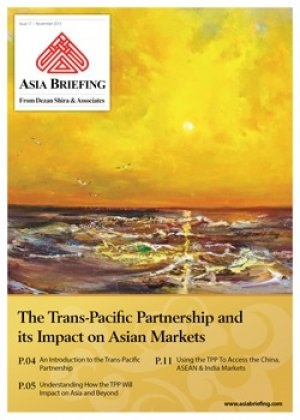Remitting Profits in ASEAN – Part 1: Singapore and Malaysia
 By: Dezan Shira & Associates
By: Dezan Shira & Associates
Editor: Anais Robin
When setting up business entities within foreign jurisdictions, one of the most important considerations pertains to the requirements and restrictions placed upon the repatriation of profits. Not only can this have a direct impact on the extent of realized gains, but it can also act to delay payments to creditors and parent companies.
Due to the wide variety of regulatory stances taken by individual nations, remittance policy is an important consideration for investors and can substantially impact the ability of a given market to attract investment. In the following series of articles, ASEAN Briefing looks into the policies employed by ASEAN member states with regard to remittances.
This first segment will introduce common restrictions placed on remittances and outline remittance policies employed by two of ASEAN’s most competitive economies – Singapore and Malaysia.
 RELATED: International Tax Planning Services from Dezan Shira & Associates
RELATED: International Tax Planning Services from Dezan Shira & Associates
Remittance Polices: What you need to Know
Methods of Repatriation
The common methods of profit repatriation are through dividends, interest, and royalties.
- Dividends: These refer to payments to shareholders of a given company, who can be corporate or individual investors.
- Royalties: These are paid for the use of property – intellectual or otherwise – leased to the company in question by another company.
- Interest: Involve loans payments to parties outside of the country in question.
Withholding Tax
Withholding taxation is the primary means of taxing remittances from a given country. In addition to corporate income tax rates – which are levied regardless of the final destination of the profits in question – withholding tax is only applied in the event that capital is transferred outside of the country through the methods described above. Countries will withhold certain percentages as part of the transfer.
Many countries apply a range of withholding taxes for a given method of transfer. For dividends, the ownership of the company will often determine the rate; for royalties, the nature of the property being used will determine the applied rate. Any company investing within ASEAN should pay close attention to the fine print of respective tax laws to discern what rates their strategy will be subject to and adjust operations accordingly.
Double Taxation Agreements
Many countries are party to double taxation agreements (DTAs) that reduce withholding rates below those applied under normal circumstances. While Singapore is known for its extensive network of arrangements, many countries throughout the region are party to many DTAs, which should be extensively consulted prior to investment within various markets or remittance of profits.
Pre-Remittance Compliance
For some countries, before being allowed to distribute and repatriate profits, foreign invested enterprises must complete annual compliance requirements. While not limited to the items listed below, common requirements for remitting profits include the completion of:
- auditing
- annual tax reporting
- annual corporate announcements
Loss and Loss Prevention
In addition to pre-remittance compliance, in some cases, not all profit can be repatriated and must be set aside in order to remedy potential operation loss. Foreign invested enterprises may also not be authorized to transfer profit abroad in the case of accumulated losses in financial reports.
Foreign Exchange Restrictions
While increasingly uncommon, the denomination of transfers may be restricted and exchange rate set at levels independent from the going market rate in some countries. This can prove to be very costly and thus it is highly recommended that companies consult with specialists prior to market entry to help mitigate the impact of these policies.
Timing repatriation
More common than foreign exchange controls, the timing of repatriation may be limited. In most cases, profit repatriation can be conduced just a limited number of times over a given period. Furthermore, in instances where compliance is required as a prerequisite for repatriation of profits, a defacto time restriction becomes imposed.
 RELATED: Annual Audit and Compliance in ASEAN
RELATED: Annual Audit and Compliance in ASEAN
Remittance Policy in Singapore:
As one of the most competitive locations to do business in the world, Singapore employs very few of the regulations described above. Loss prevention requirements, foreign exchange restrictions, timing requirements, and pre-remittance compliance are not used within Singapore. Under the authority of the Inland Revenue Authority of Singapore, the following withholding rates are however applied:
Dividends: Singapore does not impose a withholding tax on dividends meaning that these transfers can be made freely without restriction.
Interest: Currently interest payments are subject to a 15 percent withholding tax unless lowered by a double taxation agreement. If, however, the income used to make this payment is derived from Singapore based operations of a non-Singapore tax resident, interest will be taxed at the corporate tax rate of 17 percent.
Royalties: Royalties are approached in a manner similar to interest in Singapore. A 10 percent rate is the standard rate and only lowered in the event of a double taxation agreement. When the income used to make royalty payments is derived by a non-resident within Singapore, this remittance is then subject to the corporate tax rate of 17 percent.
Remittance Policy in Malaysia:
Similar to Singapore, repatriation of dividends, royalties, and interest can be done without structural restrictions in Malaysia. The only issues that investors should be sure to watch out for are the applied withholding rates that are in force within the country.
Dividends: Subject to a 0 percent withholding tax and can be transferred freely out of the country.
Interest: Malaysian authorities currently apply a 15 percent withholding rate for interest payments. Despite the seemingly high rate, Malaysia provides exemptions in the following circumstances:
- Interest is paid to a non-resident by a bank with operations within Malaysia.
- Interest that is paid on what the Central Bank describes as “net working funds”
Note: Investors should regulatory check in with the central bank as exemptions change frequently.
Royalties: Royalty withholding tax in Malaysia ranges from 10 to 13 percent depending on the status of the party remitting payments. For those that do not have a Permanent Establishment (PE), a rate of 10 percent is applied. If, on the other hand, the party in question does have a PE, the rate is increased to 13 percent.
|
Asia Briefing Ltd. is a subsidiary of Dezan Shira & Associates. Dezan Shira is a specialist foreign direct investment practice, providing corporate establishment, business advisory, tax advisory and compliance, accounting, payroll, due diligence and financial review services to multinationals investing in China, Hong Kong, India, Vietnam, Singapore and the rest of ASEAN. For further information, please email asean@dezshira.com or visit www.dezshira.com. Stay up to date with the latest business and investment trends in Asia by subscribing to our complimentary update service featuring news, commentary and regulatory insight. |
Annual Audit and Compliance in ASEAN
For the first issue of our ASEAN Briefing Magazine, we look at the different audit and compliance regulations of five of the main economies in ASEAN. We firstly focus on the accounting standards, filing processes, and requirements for Indonesia, Malaysia, Thailand and the Philippines. We then provide similar information on Singapore, and offer a closer examination of the city-state’s generous audit exemptions for small-and-medium sized enterprises.
 The Trans-Pacific Partnership and its Impact on Asian Markets
The Trans-Pacific Partnership and its Impact on Asian Markets
The United States backed Trans-Pacific Partnership Agreement (TPP) includes six Asian economies – Australia, Brunei, Japan, Malaysia, Singapore and Vietnam, while Indonesia has expressed a keen willingness to join. However, the agreement’s potential impact will affect many others, not least of all China. In this issue of Asia Briefing magazine, we examine where the TPP agreement stands right now, look at the potential impact of the participating nations, as well as examine how it will affect Asian economies that have not been included.
 An Introduction to Tax Treaties Throughout Asia
An Introduction to Tax Treaties Throughout Asia
In this issue of Asia Briefing Magazine, we take a look at the various types of trade and tax treaties that exist between Asian nations. These include bilateral investment treaties, double tax treaties and free trade agreements – all of which directly affect businesses operating in Asia.








